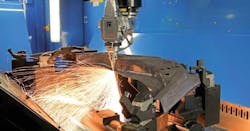Multikilowatt laser to boost automotive manufacturing speed and efficiency
TAMPERE, FINLAND – A team of European scientists is developing a new high-power multikilowatt laser for the automotive manufacturing industry that aims to reduce waste products by 10%, chassis costs by 5%, and manufacturing time by two-thirds (FIGURE). Operating at 1.5 km/s, the new laser will be powerful enough to cut the hardest boron steel used in car construction at 1 cm3/min—over 1000X faster than existing technology that currently ablates steel at 1 mm3/min.
Exerting an average power of 2.5 kW, or 100 kW in a single pulse, and with repetition rates up to 1 GHz, the laser will have the control and refinement to etch molds for vehicle parts at micron-scale accuracy as well as micro-weld dissimilar metals for solar thermal absorbers.
Boron steel, which is used in car bodies because of its super strength, is so durable that it is often difficult to cut or shape. The processes used to ensure its durability usually remove many of the steel’s fundamental properties, such as the workability. Although boron steel can be cut with a plasma arc torch (a tool that cuts using high-pressure, accelerated jet of hot plasma), this can instantly heat the metal to over 650°C (1200°F) and is not as precise or as quick as a pulsed laser.
Going by the acronym PULSE, the consortium behind the powerful new laser draws on expertise from 11 research institutions and industry partners from six different European countries and is coordinated by Tampere University in Finland.
“By harnessing the unique characteristics of a patent-protected tapered double-clad fiber amplifier power-scaled multichannel laser, the PULSE project will create unparalleled high-power beam qualities, M2 <1.1, and pulse energies 2.5–250 µJ,” says project coordinator Regina Gumenyuk.
The laser system will enable an improved digital design to lighten vehicle chassis weight with benefits to fuel economy and increase the range of electric vehicles. The consortium expects a prototype to be ready by 2021.
For more information, please visit pulse-laser.eu.
